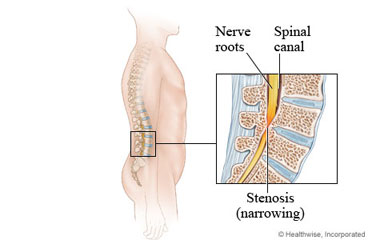
Overview
Stenosis in the spine is a narrowing of the canal that is around the spinal cord and nerve roots in your back. It can happen as part of aging. Sometimes bone and other tissue grow into this canal and press on the nerves that branch out from the spinal cord. This can cause pain, numbness, and weakness. When it happens in the lower part of your back, it is called lumbar spinal stenosis. It can cause problems in the legs, feet, and rear end (buttocks).
You may be able to get relief from the symptoms of spinal stenosis by taking medicine. Your doctor may suggest physical therapy and exercises to keep your spine strong and flexible. Some people try steroid shots to reduce swelling. If pain and numbness in your legs are still so bad that you cannot do your normal activities, you may need surgery.
Follow-up care is a key part of your treatment and safety. Be sure to make and go to all appointments, and call your doctor if you are having problems. It's also a good idea to know your test results and keep a list of the medicines you take.
How can you care for yourself at home?
- Take an over-the-counter pain medicine. Nonsteroidal anti-inflammatory drugs (NSAIDs) such as ibuprofen or naproxen seem to work best. But if you can't take NSAIDs, you can try acetaminophen. Be safe with medicines. Read and follow all instructions on the label.
- Do not take two or more pain medicines at the same time unless the doctor told you to. Many pain medicines have acetaminophen, which is Tylenol. Too much acetaminophen (Tylenol) can be harmful.
- Stay at a healthy weight. Being overweight puts extra strain on your spine.
- Change positions often when you sit or stand. This can ease pain. It may also reduce pressure on the spinal cord and its nerves.
- Avoid doing things that make your symptoms worse. Walking downhill and standing for a long time may cause pain.
- Stretch and strengthen your back muscles as your doctor or physical therapist recommends. If your doctor says it is okay to do them, these exercises may help.
- Lie on your back with your knees bent. Gently pull one bent knee to your chest. Put that foot back on the floor, and then pull the other knee to your chest.
- Do pelvic tilts. Lie on your back with your knees bent. Tighten your stomach muscles. Pull your belly button (navel) in and up toward your ribs. You should feel like your back is pressing to the floor and your hips and pelvis are slightly lifting off the floor. Hold for 6 seconds while breathing smoothly.
- Stand with your back flat against a wall. Slowly slide down until your knees are slightly bent. Hold for 10 seconds, then slide back up the wall.
- Remove or change anything in your house that may cause you to fall. Keep walkways clear of clutter, electrical cords, and throw rugs.
When should you call for help?
Call 911 anytime you think you may need emergency care. For example, call if:
- You are unable to move a leg at all.
Call your doctor now or seek immediate medical care if:
- You have new or worse symptoms in your legs, belly, or buttocks. Symptoms may include:
- Numbness or tingling.
- Weakness.
- Pain.
- You lose bladder or bowel control.
Watch closely for changes in your health, and be sure to contact your doctor if:
- You have a fever, lose weight, or don't feel well.
- You are not getting better as expected.
Where can you learn more?
Go to http://www.healthwise.net/patientEd
Enter X327 in the search box to learn more about "Lumbar Spinal Stenosis: Care Instructions".
Current as of: July 31, 2024
Author: Ignite Healthwise, LLC Staff
Clinical Review Board
All Ignite Healthwise, LLC education is reviewed by a team that includes physicians, nurses, advanced practitioners, registered dieticians, and other healthcare professionals.

